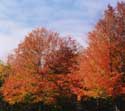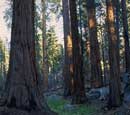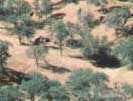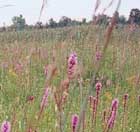THE NATURAL ENVIRONMENT
Geography 101
ToC
LIFE
Animals
Biomes
Tropics
Temperate
Cold
Hawai'i
Temperate Biomes
|
|
BOX 1 |
The climate of the midlatitudes is much more variable than the tropics. As the Earth orbits the Sun, the seasons alternate back and forth between the northern and southern hemisphere and plants must cope with sometimes extreme seasonal changes in temperature and moisture. In general, the temperate biomes of the midlatitudes have less species diversity than their tropical counterparts.
While the climate of the tropics is dominated by the ITCZ and subtropical High pressure centers, the midlatitude zones are dominated by the movements of air masses, as described in Chapter 6 -> Air Masses. Also, ocean currents moving in opposite directions on opposite sides of continents and mountain ranges can produce distinctly different climate and vegetation zones between east and west coasts. Look at North America in the map below, for example. The vegetation zones clearly vary more in an east-west direction than in the north-south direction, as was the case in the tropics.

Temperate Forests
 Temperate
deciduous forest dominates large tracts of
the Eurasian and North American continents. Deciduous means that the
trees lose their
leaves during the cold, or sometimes dry, season. In colder climates,
this helps prevent frost damage as trees "harden" their tissues for the
coming winter. Broadleaf trees, like oak, elm, hemlock, maple, and beech, dominate these forests. They cover most of the eastern portions
of North America and Asia, as well as most of Europe south of Scandinavia.
Temperate
deciduous forest dominates large tracts of
the Eurasian and North American continents. Deciduous means that the
trees lose their
leaves during the cold, or sometimes dry, season. In colder climates,
this helps prevent frost damage as trees "harden" their tissues for the
coming winter. Broadleaf trees, like oak, elm, hemlock, maple, and beech, dominate these forests. They cover most of the eastern portions
of North America and Asia, as well as most of Europe south of Scandinavia.
 The
wet western coasts of North and South America and most of New Zealand
and Tasmania support temperate evergreen forest.
These are dominated by coniferous species,
such as redwood and fir, but also containing many broadleaf species. The
climate of these areas is fairly stable year-round
as onshore
winds
bring plenty of rain to the windward slopes of coastal mountain ranges
and keep temperatures cool in summer and relatively warm in winter.
It remains something of a mystery in biogeography why broadleaf forests
dominate the eastern part of North America, while at the same latitudes,
conifers dominate the west coast.
The
wet western coasts of North and South America and most of New Zealand
and Tasmania support temperate evergreen forest.
These are dominated by coniferous species,
such as redwood and fir, but also containing many broadleaf species. The
climate of these areas is fairly stable year-round
as onshore
winds
bring plenty of rain to the windward slopes of coastal mountain ranges
and keep temperatures cool in summer and relatively warm in winter.
It remains something of a mystery in biogeography why broadleaf forests
dominate the eastern part of North America, while at the same latitudes,
conifers dominate the west coast.
 Mediterranean biome, also called chaparral in California and maquis in Europe,
occurs on the fringes of the Mediterranean Sea and in small patches on
the west coasts of North and South America, Western Australia, and the
southern tip of Africa. These areas have unusual climates with
wet winters and
long,
dry summers (that's why Europeans head to the Med
for their summer vacations). Other places in the world receive most
of their rainfall in summer. Mediterranean biome consists of tough grasses, cacti and scattered, short trees like olive and scrub oak that are well adapted to drought and frequent fire.
Many species, in fact, require wildfire to
initiate seed germination. (NOTE: like the Mediterranean biome, Hawai'i is one
of the few places on Earth to receive most of its rainfall in the
winter months).
Mediterranean biome, also called chaparral in California and maquis in Europe,
occurs on the fringes of the Mediterranean Sea and in small patches on
the west coasts of North and South America, Western Australia, and the
southern tip of Africa. These areas have unusual climates with
wet winters and
long,
dry summers (that's why Europeans head to the Med
for their summer vacations). Other places in the world receive most
of their rainfall in summer. Mediterranean biome consists of tough grasses, cacti and scattered, short trees like olive and scrub oak that are well adapted to drought and frequent fire.
Many species, in fact, require wildfire to
initiate seed germination. (NOTE: like the Mediterranean biome, Hawai'i is one
of the few places on Earth to receive most of its rainfall in the
winter months).
Temperate Grasslands
Toward the interior of continents in midlatitudes, rainfall becomes less dependable and climate becomes more continental (see Chapter 3 -> Heat). The climate becomes too dry to support continuous forest and grasses dominate. Unlike savannas, few trees grow to interrupt the horizon, giving enormous vistas of sky and grass. Huge swaths of grassland cover the interiors of the Americas and Asia. These areas are called by various names around the world, such as steppe in central Asia, veldt in South Africa, and prairie in North America.
 The
wetter grasslands produce deep, black soils and include some of the richest
agricultural land in the world, called tall
grass prairie in
North America and pampa in South America. Deeply
rooted perennial grasses, such as Big Bluestem, originally covered these
areas growing up to two meters high.
The sod of these grasses was so tough that early American pioneers chopped
it into bricks to build temporary cabins, called soddies. Today,
most of the tall grass prairie has been plowed under and replaced with
crops like corn and soybeans. Only a few small patches have been protected.
The
wetter grasslands produce deep, black soils and include some of the richest
agricultural land in the world, called tall
grass prairie in
North America and pampa in South America. Deeply
rooted perennial grasses, such as Big Bluestem, originally covered these
areas growing up to two meters high.
The sod of these grasses was so tough that early American pioneers chopped
it into bricks to build temporary cabins, called soddies. Today,
most of the tall grass prairie has been plowed under and replaced with
crops like corn and soybeans. Only a few small patches have been protected. 
In drier areas, short grass prairie dominates. The low growing grasses, such as Buffalo grass, can form a continuous layer, or in drier areas, form tufts separated by patches of bare soil. With relatively low fertility and limited rainfall, many of the short grass prairies have been converted to pasture for grazing cattle and sheep. Most of the Asian steppe is short grass prairie.
Temperate Deserts
Temperate deserts are the poleward extension of tropical deserts into the interiors of continents. The tropical deserts of North Africa and the Middle East, for example, extend north and east into the interior of Asia. These locations are dry, either because of mid-continental location, such as central Asia, or because they lie in the rainshadow of mountain ranges, such as California's interior deserts.
A cold winter season characterizes temperate deserts. Otherwise, they are similar to the tropical deserts in receiving less than 25 cm (10 inches) of rainfall per year and requiring the same plant and animal strategies for survival, with the additional requirement that they may have to endure freezing temperatures.